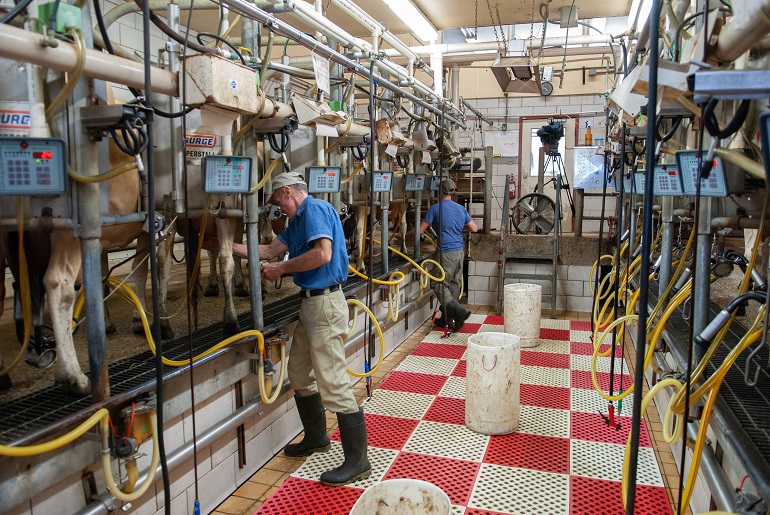Mastitis in Cattle – Causes, Symptoms and Management

This post is also available in:
This post is also available in:
![]() Español (Spanish)
Español (Spanish) ![]() Français (French)
Français (French) ![]() हिन्दी (Hindi)
हिन्दी (Hindi) ![]() Ελληνικά (Greek)
Ελληνικά (Greek) ![]() Português (Portuguese (Brazil))
Português (Portuguese (Brazil))
The occurrence of mastitis indicates some failure in milking management
Major causes of mastitis are:
- Application of the wrong milking techniques
- Neglecting hygienic measures like not having washed the hands and teats before milking
Signs of mastitis
- The affected udder is hard and painful when touched
- The milk yield is lowered
- The milk is abnormally coloured and appears bloody
Mastitis is a multifactorial disease in cows that is closely related to the production system and environment. Mastitis risk factors can be classified into 3 groups: host, pathogen, and environmental determinants. Somatic cell counts (S.C.C.) are used to measure milk quality, with the legal limit for saleable milk being 400,000 cells/ml. S.C.C. levels increase rapidly when bacteria enter the udder as immune cells attempt to fight the infection. High S.C.C. levels in milk cause deterioration of milk quality, and in cases of chronic infection, S.C.C. levels can remain high throughout lactation.
- Genetic resistance:
Cow and udder conformation:
Udder and foot conformation have been shown to be important risk factors for mastitis. Most conformation-related traits have high heritability, and are generally recognized by farmers and herdsmen as major selection criteria for breeding.
- Milk yield:
There is substantial evidence to suggest that high yields are linked to high mastitis levels.
- Nutritional status:
Various nutritional factors may lower a cow’s disease resistance. Energy, protein and mineral/trace element deficiencies may affect disease resistance and S.C.C. levels.
Selenium supplementation has been seen to improve immunity to mastitis.
- Age of host:
Both mastitis incidence and S.C.C. levels are higher in older cows.
Stage of lactation: Most mastitis surveys show that 2/3 of all clinical mastitis cases occur in early lactation.
- Other diseases: It is recognized that other diseases, particularly ketosis, milk fever, lameness and retention of placenta, are closely associated with mastitis incidence.
- Vaccination status of host: Ε. coli is the only mastitis pathogen that cows are commonly vaccinated against.
Mastitis pathogens: Increased emphasis on somatic cell count reduction and targeting certain contagious micro-organisms (i.e. Streptococcus agalactiae).
Contagious mastitis pathogens adhere to the epithelial cells of the udder and can be eradicated through antimicrobial therapy or culling and biosecurity. Environmental mastitis bacteria include various species and can grow in the cow’s environment, so it is recommended to use straw as bedding material and ensure access to dry-lying areas. The introduction of new pathogens into the herd is a likely risk factor for mastitis and can be prevented by a closed herd policy. The presence of chronically infected cows is a significant risk factor for mastitis, and mastitis treatment practices affect the transmission of pathogens within the herd. Milking hygiene, including separating or milking infected cows last, keeping udders and teats clean, and disinfecting teats before or after milking, can prevent the spread of contagious mastitis. Teat injuries can lead to improved survival of pathogens on the teat and tend to be caused by lameness and inappropriate housing systems. Udder cleanliness is an essential factor in the general resistance to mastitis, and milking machine faults and poor milking techniques are environmental risk factors for mastitis. Finally, preventing cows from lying down until the teat canal has closed can help prevent bacterial penetration.
The Five-Point Plan for Control of Mastitis in Dairy Herds
- Routine post-milking teat dipping.
- Prompt treatment of clinical mastitis with antibiotics.
- Blanket antibiotic dry cow therapy for the whole herd.
- Culling of cows with chronic mastitis.
- Milking machine maintenance with annual testing.
- Improved housing is also encouraged.
Read more in the book of the author “Success in agribusiness: Profitable milk production”, by James Mwangi Ndiritu
Pests in Cattle- External Parasites
Pests in Cattle- Internal Parasites
Serious Cattle Diseases caused by Pathogenes
Mastitis in Cattle – Causes, Symptoms and Management








































































